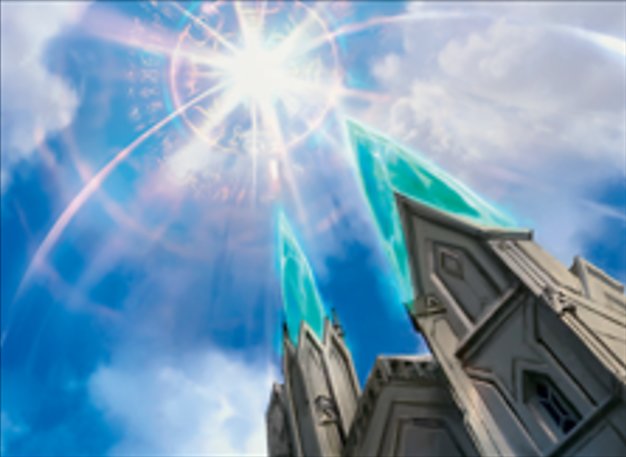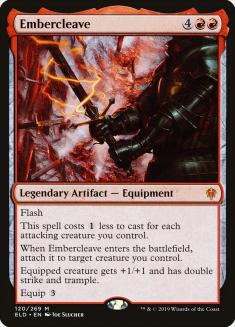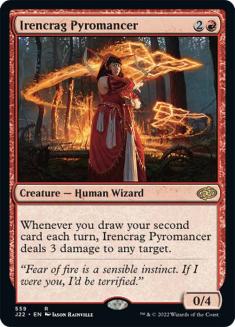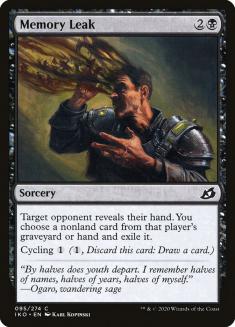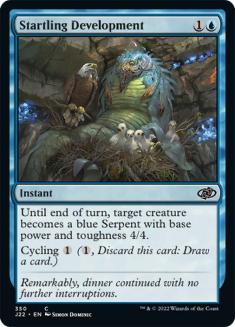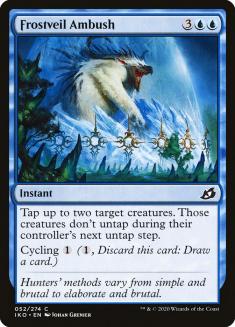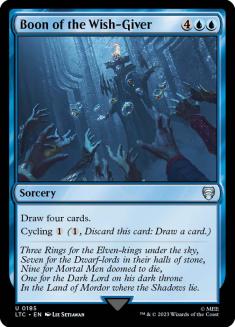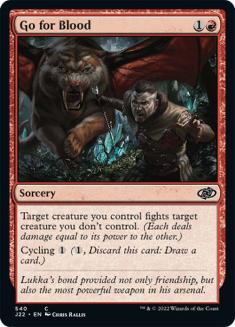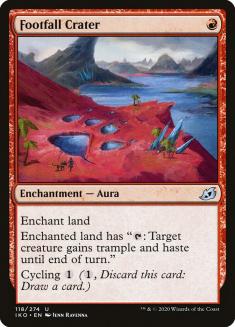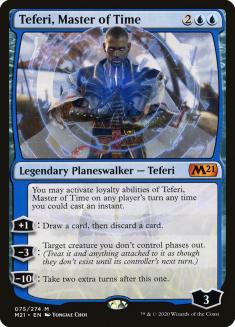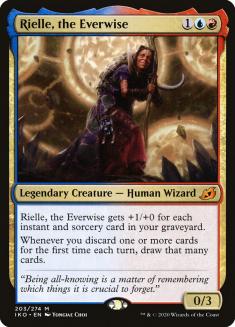As soon as Ikoria: Lair of Behemoths was released, Cycling decks immediately became very popular. They were explosive and relatively consistent, and preyed on the decks that were still untuned at the start of a format. Once the format established itself and other decks reached their final forms, the deck was relegated to Tier 2/3 and never managed to break through to the upper echelons again.
Given the nature of the Cycling deck, it’s very hard for it to get meaningful updates — most of the cards need to either be cyclers or cycling payoffs, and it’s not something you’re likely to find in the average set. As a result, the deck has remained mostly the same for the past year, and, given that it wasn’t very good before, it makes sense that an identical version wouldn’t be good all of a sudden.
This was the train of thought that left me basically neglecting Cycling as a deck as the February Kaldheim League Weekend approached. I was aware of the numbers the deck was putting up, of course, but logically it wasn’t any better than it was before, and I knew it was bad before, so it didn’t seem worth wasting time figuring out that it was bad again.
At this point, the deck has been putting up enough consistent results that it’s obvious that it’s not a fluke — the deck is, somehow, better than it was before, even though it hasn’t gained any new cards. And why is that? In my mind, there are three reasons.
Reason 1: Embercleave has been dimming in popularity. I believe this is actually the biggest reason the deck is better now. Cycling is not a slow deck but it’s also not very fast and it relies on chump-blocking with 1/1 creatures until you can construct a Zenith Flare. Embercleave destroys this plan singlehandedly. In Zendikar Rising Standard, basically every aggro deck was an Embercleave deck, whereas in Kaldheim Standard most aggro decks are not running the Equipment.
A month ago, all the Adventure-based decks were strictly Gruul and they all ran three or four Embercleaves. Nowadays, we have Naya Adventures, Naya Fury, Naya Tokens, and Temur Adventures, all of which I expect to be more popular than straight Gruul Adventures (and also better, for the most part, so it’s a trend we can expect to continue). We also have Mono-White Aggro❄, which obviously can’t run Embercleave either. All in all, the Embercleave metagame share is simply much smaller.
Reason 2: Dimir Rogues has fallen out of popularity as well. There’s some debate as to whether Dimir Rogues is actually good versus Cycling, but my experience has been that the matchup always favored Dimir Rogues — most of the games end up with Cycling having a lethal Zenith Flare and Dimir Rogues countering it and decking them. I believe as a Cycling player you would rather not play versus Dimir Rogues, so the deck’s decline in popularity is also good for you.
Reason 3: Irencrag Pyromancer.
Not every build of Cycling plays Irencrag Pyromancer (in fact, until the February Kaldheim League Weekend, almost no builds did), so it’s hard to credit Irencrag Pyromancer for the deck’s resurgence in popularity, but I think it’s important to recognize that a deck can evolve even though it hasn’t gotten any new cards because the format changing can make older cards better. Irencrag Pyromancer just happens to be in the sweet spot where it dodges Bonecrusher Giant, Giant Killer, and Fire Prophecy, which means a lot of the aggressive decks don’t have good ways of killing it, especially in Game 1 when they don’t have Glass Casket or Redcap Melee.
Which Version of Cycling Should You Play?
Right now, there are many versions of Cycling decks flying around. Let’s take a look at them:
Creatures (16)
Lands (19)
Spells (25)

“Four-Color” is a bit of a stretch for this deck, given that the only black card is Memory Leak which you’re hardly ever casting, but most websites have this differentiation. Otherwise this deck is the same as Jeskai Cycling (Lurrus) and any Jeskai version can be made a Four-Color version just by playing some Pathways.
Creatures (16)
Lands (19)
Spells (25)

This is the standard version of the deck and the one that has existed since forever. Whether you play the black cards or not, your plan is the same — you either win with an early Flourishing Fox or you win with a late Zenith Flare. Most of the time, your creatures pressure the opponent enough so that a Flare finishes them off.
Creatures (19)
- 4 Irencrag Pyromancer
- 4 Drannith Stinger
- 4 Flourishing Fox
- 3 Valiant Rescuer
- 1 Rielle, the Everwise
- 3 Drannith Healer
Planeswalkers (2)
Lands (20)
Spells (19)

This is the most different of the versions, as it eschews Lurrus completely in favor of Irencrag Pyromancer and Rielle, the Everwise. Greg’s version has less of a cycling theme and more of a “draw two cards” theme, even going as far as being the only person in the last year other than Shaheen Soorani to play Teferi, Master of Time.
This is a relatively slower build, as it plays fewer cyclers than the average version, so its Foxes and Zenith Flares are not as threatening — in return, it gains another avenue to win the game. Greg even went as far as playing only three Flares, though that’s not something I really agree with.
The Maindeck
To decide which version is best, let’s look at the individual cards.
The cost of having Memory Leak is very small — it is, after all, a cycler, and this deck is playing a lot of very bad cards because they have cycling. It doesn’t affect your manabase unless you let it (meaning that if you ever play a Pathway on black and then end up needing the other color, it’s strictly on you), so the only cost is the opportunity cost of not playing a different cycler. To decide whether it’s worth it or not, I think we should just rank the cyclers and then go down the list based on how many cyclers we want. If we reach Memory Leak, we add as many black sources as we can.
When doing this list, we need to keep in mind that every card is bad and unlikely to be cast — it’s just a question of how likely and how good they are when their fringe scenario does come up.
Startling Development is, to me, the best cycling spell in the deck and the one I cast the most by a significant amount. Most of the time it acts as an extra three damage on an unblocked token but sometimes you use it in combat too.
I think Frostveil Ambush is the worst cycling card overall, as it’s very hard to cast and just doesn’t come up enough. In all my games playing Cycling or against Cycling, it’s the only of those cards I’ve literally never even seen cast.
Casting Boon doesn’t come up as often, but it has the biggest impact when it does come up, since it has the ability to swing a game by itself when you’re flooded. This is exactly what I want in my cycling cards, as I’m unlikely to want to cast them to begin with, so I want them to be very good when I do cast them. Boon is especially good in the Pyromancer / Improbable Alliance versions since the games tend to go longer, so you actually hit six mana and it triggers these effects just like cycling would.
I think Memory Leak would be highly placed if it were as castable as the other cards. As it is, you need a true planetary convergence to arrive in a spot where you both want to cast it and are able to cast it, as neither is individually very likely to happen in a game. Still, it does have uses, especially against decks like Sultai Ramp (Yorion) or decks like Dimir Rogues which run counterspells that aren’t foretold (it’s not very effective against Saw It Coming). This card gets worse the more color commitments you have (for example, Improbable Alliance) because the likelihood you can play a Pathway on black early on in a deck like this is very small.
Go for Blood is the card that looks the most playable outside of Boon of the Wish-Giver, so it was surprising to me when I realized I didn’t cast it nearly as much as I expected. Your deck is just very bad at fighting outside of Flourishing Fox, and most of the time it’s better to just cycle and get a new card than to trade one of your creatures for one of theirs. There are exceptions, of course — sometimes you sacrifice a Drannith Healer to kill a Lurrus or you just kill an Edgewall Innkeeper or a Giant Killer that has been keeping your Fox at bay — but the reality is that this card is also rarely cast.
Footfall Crater is similar to Boon in that you’re rarely casting it (even more rarely than the others), but when you do cast it, it can win you the game by giving a big Fox trample, which can come up a lot in mirror matches as the tokens can block everything. The biggest upside to this card over the others is that Lurrus can cast it from the graveyard and it’s actually relevant (it can give the Lurrus itself haste, for example), so I think this card is much better in the Lurrus version than the Pyromancer version.
If you play Rielle, Footfall Crater becomes better to cast (since you get another high-power attacker) but worse to cycle since it’s not an instant or sorcery in the graveyard. Given that you’re cycling it 99% of the time anyway, I would say I’d rather have a better cycler than a better spell.
So, how would I rank them?
In the Lurrus version:
- Startling Development
- Footfall Crater
- Boon of the Wish-Giver
- Go for Blood
- Memory Leak
- Frostveil Ambush
In the Irencrag Pyromancer deck:
- Startling Development
- Boon of the Wish-Giver
- Go for Blood
- Memory Leak
- Footfall Crater
- Frostveil Ambush
As an experiment I asked Twitter how they would rank these cards…
…and basically got all possible variations of ranks (including the same card in literal first and literal last several times) so the difference here really is not that big and it’s not something you should lose a lot of sleep over, but this is how I would generally rank them. I would then go down the list filling in my cycling slots until I run out, and if I end up with Memory Leak in my deck I’ll add some black sources.
Now, as to the other cards:
Lurrus is a good card in Cycling, but it’s important to realize that this is definitely not a Lurrus deck. Dimir Rogues (Lurrus) in Standard and Azorius Auras (Lurrus) in Historic are example of decks I could classify as “Lurrus decks” — access to Lurrus is integral to their gameplans and they will go to great lengths to be able to use the card. There are expensive permanents I’d potentially want to play in Dimir Rogues (Zareth San, the Trickster; Cosima, God of the Voyage; Shark Typhoon…) that I don’t because they would restrict access to Lurrus and my deck just doesn’t work as well without it.
Cycling is not like that. In Cycling, Lurrus is just a bonus like Jegantha is in Jund Sacrifice. You should always play it if you can, but you should not make big sacrifices to be able to play it, and access to it is not a key difference-maker between the lists because it’s just not that good in this deck.
I’ve been very impressed by Improbable Alliance. It’s not the best at attacking, but being able to block flyers is integral to your gameplan against Goldspan Dragon and Maul of the Skyclaves — you need to stall the game to be able to Zenith Flare them out and without this card you often can’t do it. I would play four copies.
Having access to Irencrag Pyromancer is mostly going to define whether we want Lurrus or not — the other cards don’t feel strong enough to give the companion up, but Pyromancer might. Personally, after playing with both versions of the deck, I think the one with Pyromancer is just better. As I mentioned before, the card is actually quite hard to deal with — it survives Giant Killer, Bonecrusher Giant, and Fire Prophecy, and that’s the extent of the removal in most aggressive decks these days, at least in the maindeck.
On top of just being a strong card against creatures, Irencrag Pyromancer offers the deck another angle of attack that’s not dependent on an early Flourishing Fox or a late-game Zenith Flare. Before Pyromancer, someone who had one early removal spell and a way to empty your graveyard would often have all their bases covered, and now with Pyromancer and Improbable Alliance you can just play a different kind of game that’s harder to hate out. Now that Cycling decks have gotten more popular, you can see the number of graveyard-hate cards already increase in everyone’s sideboards, so having a way to win that bypasses it can be quite valuable.
It’s undeniable, however, that Pyromancer is quite a bad card versus non-aggressive decks, such as Esper Blink (Yorion) or Sultai Ramp (Yorion), so you basically have to choose what you want to be good against. Personally I think right now it makes more sense to be good against aggro and stronger against graveyard hate, which is why I favor Pyromancers.
When I first saw Teferi, Master of Time in Greg’s list, I thought there was no way it was going to be good. After playing with it, I can say my suspicions were confirmed.
The main issue with this card is that this deck has two sides to it — one where you just cast creatures early and kill them quickly, and another where you’re trying to stall the game, trigger your “draw two cards” effects, and eventually kill them with a big Zenith Flare. Teferi, Master of Time can be quite good in the second scenario, but it’s absolutely useless in the first one, as you just can’t afford to tap four mana for a card that has no meaningful impact on the battlefield, whereas doing anything else will grow your creatures, deal them damage, or generate more tokens.
I can see where Greg’s heart was at with Teferi, but I just don’t think it fits this deck. On top of everything, double-blue by Turn 4 is certainly not trivial.
When I first saw Rielle, the Everwise in Greg’s list, I thought there was no way it was going to be good. After playing with it, I was actually pleasantly surprised! It’s not hard to get extra cards out of Rielle, and if it lives, it becomes trivial to trigger both Pyromancer and Improbable Alliance on your turn and on their turn as well. It doesn’t dodge as much removal as Pyromancer, but it does survive Bonecrusher Giant and early in the game can also survive Giant Killer, so there’s a reasonable chance you cast Rielle and untap with it.
I think if your choice is Rielle or Lurrus, Lurrus is better, but if you are already playing Pyromancer, then a copy or two of Rielle could certainly belong. Right now I like every other card in my list more, but I have one in the sideboard and could see playing one in the maindeck in the future.
This is the list I’ve been playing:
Creatures (20)
Lands (20)
Spells (20)

The Sideboard
Sideboarding with this deck is a bit tricky because every card plays a role — it’s either a cycler payoff, a cycling enabler, or both. You often end up cutting some cyclers from your deck, which is not ideal because they’re the engine that makes your deck churn, but in a lot of matchups there’s simply nothing else to take out. The big exceptions are control decks, because Irencrag Pyromancer is bad versus all of them, and Improbable Alliance is not good versus the ones with a “big kill” like Emergent Ultimatum.
Because of this, I think sideboard cards for this deck need to be very specific. I’m looking for cards that are narrow in application and large in impact. I’m not interested in a versatile card like Scorching Dragonfire because there’s no room for that — instead I want Redcap Melee, Soul-Guide Lantern, and Archon of Absolution (either that or cards that have cycling themselves, like Shredded Sails). Right now Mono-White Aggro❄ seems to be on a downswing, so I don’t have any Archons, but this can change if the metagame changes. That’s why my sideboard has a lot of two-ofs that are only good versus one specific deck.
Tips & Tricks
- You don’t need Flourishing Fox in your opening hand but you do need to be building towards something. A hand of four lands and three cyclers, for example, is just not good enough — you need to have a one- or two-drop you want to cast, or at least a Pyromancer against aggro.
- If I already have a cycling payoff, I lean towards holding Pyromancer until Turn 4 so I can cast it and cycle a card in the same turn. For example, if my Turn 2 play was Valiant Rescuer, I’d rather spend my Turn 3 cycling two cards (one on my turn and one on their turn) rather than casting a Pyromancer, because I’m only getting one trigger on Turn 4 anyway (unless you have two Pyromancers) and this way I get more value out of my two-drop and I don’t expose my Pyromancer to sorcery-speed removal (such as Skyclave Apparition).
- In the dark, you should probably be cycling on your main phase more than you currently are. We’re conditioned to doing this kind of stuff at the end of the turn, but sometimes you draw a Fox or a Triome that you want to cast and then you really regret not doing it immediately. The exception is when you have Improbable Alliance or Irencrag Pyromancer. In this case, it usually pays off to only cycle once on your turn, so you can potentially find another cycler and trigger their effects on your opponent’s turn as well.
- Most of the time you should just cycle your cards rather than wait for the perfect moment to actually cast them — it comes up very infrequently. Sometimes, however, it pays off to not cycle immediately to guarantee a trigger the following turn.
- You should know that, unlike the other cyclers, the opponent can respond to you drawing a second card by killing your Pyromancer and stop the trigger altogether. However, you can play around that by simply having another cycler up.
- If you’re playing against Dimir Rogues, don’t forget that you can cast an upkeep Zenith Flare and win with zero cards in your deck.
- If you’re playing the Lurrus version, you don’t always want to cast something from your graveyard. Sometimes it’s better to leave it there for Zenith Flare.
Overall, I’ve found Cycling to be much better than originally expected, and I don’t think its recent results are a fluke — the changes in the metagame look like they’re here to stay, at least until Strixhaven is released, so Cycling decks will almost certainly keep their spot until then. The only thing to pay attention to is whether you want to play Lurrus or Irencrag Pyromancer, and that’s metagame-dependent. In an aggro field, I think Pyromancer is clearly better, and that’s the field we’re currently in, so it’s my choice for the moment.

